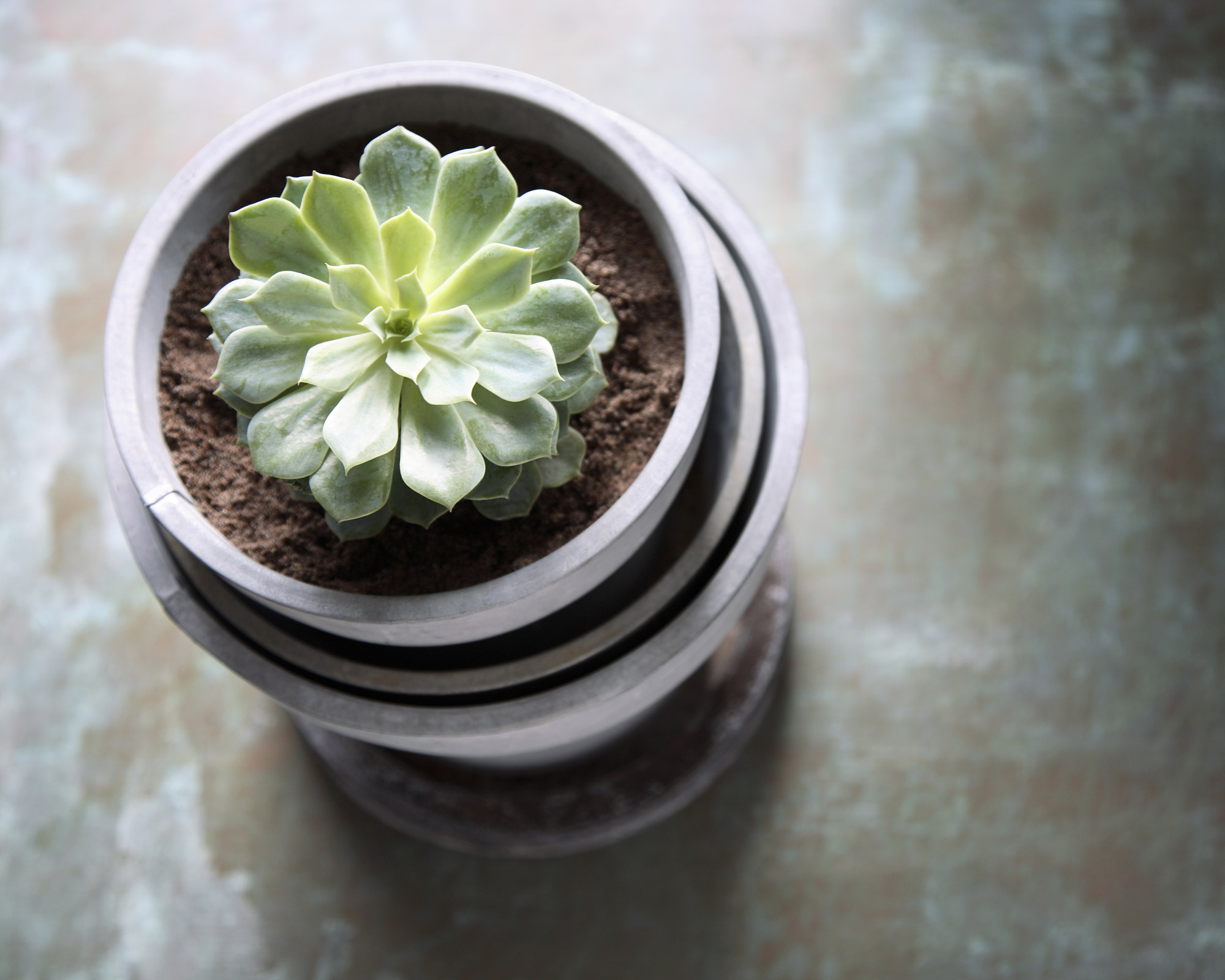When to water succulents – and how often – to keep them thriving
Find out when to water succulents so they can flourish in your home and yard


Wondering when to water succulents? These plants generally need watering less than other houseplants, so getting it just right can feel like a challenge.
One of the best indoor plants you can grow with a range of shapes, sizes and colors, succulents make a fabulous display in an interior – and, of course, they’re popular for the yard, too.
But despite the fact that they can tolerate drought conditions, it is possible to underwater succulents as well as overwater them, so our guide has the knowhow you need to keep them happy and healthy.
When to water succulents
Learning how to care for succulents isn’t hard, but it’s when it comes to watering that things often go wrong.
‘Succulents are undemanding plants that can store a large amount of water, which allows them to easily survive short periods of drought,’ explains Nastya Vasylchyshyna, a resident botanist expert for the NatureID app. ‘The most important rule to remember when it comes to watering succulents: don't overwater them.’ Here’s the lowdown.
How often should I water succulents?
How often to water succulents will depend on a number of factors. ‘The watering frequency depends on the species, the size of the plant, and care conditions,’ explains Nastya Vasylchyshyna.
‘From spring to fall, during the period of active growth, these plants should be watered once every seven to 10 days. In winter, when the light day becomes shorter, succulents go into dormancy, so you don’t need to water them more than once every three to four weeks. Cacti, being stem succulents, are able to perfectly tolerate even longer periods of drought. That’s why you can water them once every five to six weeks in winter.’
Be sure to check soil and leaves of succulents as the best guide to their watering needs, however, rather than follow a schedule.
How much water do succulents need?
‘Succulents typically need less water than other container plants and they store water in their swollen stems and leaves,’ explains Dr Clydette Alsup-Egbers, associate professor of environmental plant sciences at Missouri State University.
‘Because they are native to dryer parts of the world, succulents tend to have short root systems that are close to the soil surface so when the infrequent rain occurs, they can quickly absorb whatever moisture percolates down into the soil.’
How do you know when to water succulents?
Rather than following a rigid timetable, the key to when to water succulents is to learn to feel the soil.
‘I wait until the potting media/mix (“soil”) is on the dry side about 1 to 2in deep, which means they usually need to be watered once or twice a week if growing in full sun during the warm months of the year,’ says Dr Alsup-Egbers.
You might also be able to judge by the plant’s appearance. ‘The succulent’s leaves may show signs of drought – look for a softer, slightly wrinkled surface for an indication the plant is ready for water,’ says gardening expert at Bloomscape Lindsay Pangborn.
When succulents do need water, don’t hold back. ‘Water thoroughly until water comes out of the drainage holes at the base of the container and empty any water that accumulates in the saucer under the container,’ says Dr Alsup-Egbers.
Be aware that it can sometimes be tricky to water succulents. ‘Since succulents prefer their soil to dry completely between waterings, it's common for the soil to shrink away from the sides of the pot and become hydrophobic,’ explains Lindsay. ‘This can make it tough to properly water, since the water naturally will fall away from the soil rather than absorbing into it.
‘If this is the case, I recommend using the bottom-watering method of allowing the pot to sit in a shallow tray of water where it can absorb it through the drainage hole. After 20 to 30 minutes, remove the pot from the water and allow the excess to drain away.’
When should you water succulents in different seasons?
The season of the year definitely counts in considering when to water succulents. ‘Succulent watering needs can change at different times of the year depending on the weather,’ says Lindsay Pangborn. ‘Spring and summer are generally active growing months for succulents thanks to the warmer temperatures and longer days, and during this time you’ll notice your plant uses water more quickly, equating to more frequent watering needs.
‘During the winter, most indoor succulents go into a natural rest period and only require water once in a while. Watering succulents once every four to six weeks is normal in the winter months. Yellow or droopy leaves can indicate you’ve watered too much.’
If you find yourself asking 'why is my succulent dying?', it is likely to be a problem with the watering – especially in hotter months when your plant may become overheated. However, as the experts suggest, it is certainly possible to overwater your succulents too often in winter – so remember to refrain from watering as often in cooler seasons and listen to what your plant wants through the health of its leaves.
Watering succulents outside
The needs of plants in the yard are a little different. ‘Outdoor plants need water more frequently than those indoors sheltered from wind and direct sun,’ explains ASHS certified horticulturist Michele Chambliss of Perennial Garden Consultants.
How and where the succulents are grown matters, too. ‘Containerized succulents require more frequent water than plants in the ground,’ Michele says. ‘Succulents in maritime climates such as coastal California require less frequent irrigation events than succulents in hotter inland areas.’
In the yard, whether the plant is actively growing is crucial. ‘Aeoniums and aloes for example, tend to go dormant in the summer, and watering too frequently can rot the roots, killing the plant,’ Michele continues.
‘Cactus (which are succulents), on the other hand, require more frequent water during hot summer months, particularly in hot deserts. Like all succulents, cactus have adapted to long periods of hot, dry conditions by the development of succulent flesh that retains moisture, plus their prickles and spines help shade the plant from the sun. But they still require occasional water to look their best, and that can depend upon the amount of rainfall in a specific area. Here in Las Vegas, part of the eastern Mojave Desert, our yearly rainfall averages 4in or less. So established cactus and succulents in the ground require water about twice a month in summer.
‘When you see shriveling of the cactus in between ribs, or shriveling of a succulent, that’s an indication that watering is overdue.
‘Always water the same amount, which can vary from plant to plant. What changes throughout the seasons is frequency, not duration or amount.
‘Do not water cactus or succulents during winter unless they are actively growing. Harden off succulent plants in the fall, gradually decreasing the frequency of irrigation events. This helps the plant withstand cold temperatures without damage.’
FAQs
How do you know when a succulent needs water?
To judge when a succulent needs water, check the soil. ‘The soil moisture is a good indicator of when your succulent needs to be watered,’ says Lindsay Pangborn. ‘When the soil is completely dry (check with your finger) and the pot is very lightweight, it’s time to water.’
As for whether you’re getting when to water succulents right, you’ll be able to see. For example, your succulent may be turning yellow and have soggy-looking leaves if over-watered.
Dr Alsup-Egbers adds. ‘Underwatered succulents’ top or middle leaves will be brown, dry and crispy.’ Note, however, the plant’s natural life cycle. ‘It is normal for lower leaves to turn brown and die so that is not a cause for concern,’ she says.
It's very common to assume that succulents can manage for really long spells without water. This isn't necessarily true: keeping an eye on moisture levels in your soil is key to ensure your succulents are adequately watered, at the right time.
Sign up to the Homes & Gardens newsletter
Design expertise in your inbox – from inspiring decorating ideas and beautiful celebrity homes to practical gardening advice and shopping round-ups.

Sarah is a freelance journalist and editor. Previously executive editor of Ideal Home, she’s specialized in interiors, property and gardens for over 20 years, and covers interior design, house design, gardens, and cleaning and organizing a home for Homes & Gardens. She’s written for websites, including Houzz, Channel 4’s flagship website, 4Homes, and Future’s T3; national newspapers, including The Guardian; and magazines including Future’s Country Homes & Interiors, Homebuilding & Renovating, Period Living, and Style at Home, as well as House Beautiful, Good Homes, Grand Designs, Homes & Antiques, LandLove and The English Home among others. It’s no big surprise that she likes to put what she writes about into practice, and is a serial house renovator.
-
 A $170 limited-time discount makes this the most affordable Dyson cordless vacuum on the market right now
A $170 limited-time discount makes this the most affordable Dyson cordless vacuum on the market right nowYears after its release, the Dyson V8 still impresses us with its features and power
By Dan Fauzi Published
-
 Victoria Beckham has a unique formula for perfect bedding: 'Very expensive sheets and cheap pillows' – you can follow her example from $15
Victoria Beckham has a unique formula for perfect bedding: 'Very expensive sheets and cheap pillows' – you can follow her example from $15Victoria revealed she goes for crisp, white bed sheets and pillows with neck support from Target – and you can shop similar buys at an ultra-low cost
By Hannah Ziegler Published